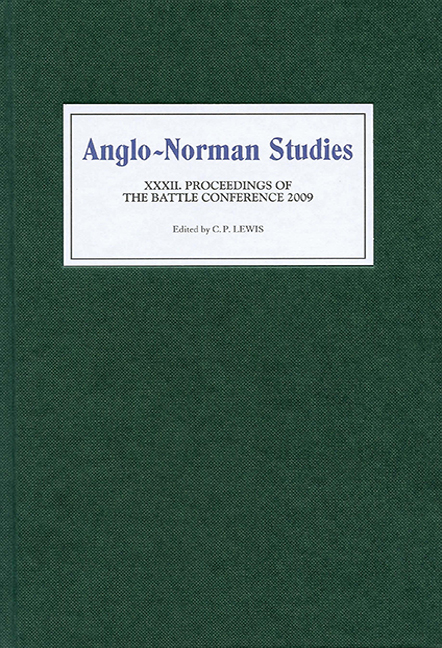Book contents
- Frontmatter
- Contents
- List of Maps and Tables
- Editor's Preface
- Abbreviations
- The Peace of God and Bishops at War in the Gallic Lands from the Late Tenth to the Early Twelfth Century
- Ad erudiendum tradidit: The Upbringing of Angevin Comital Children
- Coming and Going: The Use of Outdoor Space in Norman and Anglo-Norman Chronicles
- The Urban Transformation in England, 900–1100
- The Taming of the Laity: Writing Waltheof and Rebellion in the Twelfth Century
- Close Relations? Some Examples of Trade Links between England and the Towns and Ports of Lower Normandy in the Thirteenth and Early Fourteenth Centuries
- The Roots of the English Royal Forest
- Knighthood and Chivalry in the Histories of the Norman Dukes: Dudo and Benoît
- Prayers for the King and Royal Titles in Anglo-Norman Charters
- Domesday Mortlake
- Miscellaneous Endmatter
Domesday Mortlake
Published online by Cambridge University Press: 28 April 2017
- Frontmatter
- Contents
- List of Maps and Tables
- Editor's Preface
- Abbreviations
- The Peace of God and Bishops at War in the Gallic Lands from the Late Tenth to the Early Twelfth Century
- Ad erudiendum tradidit: The Upbringing of Angevin Comital Children
- Coming and Going: The Use of Outdoor Space in Norman and Anglo-Norman Chronicles
- The Urban Transformation in England, 900–1100
- The Taming of the Laity: Writing Waltheof and Rebellion in the Twelfth Century
- Close Relations? Some Examples of Trade Links between England and the Towns and Ports of Lower Normandy in the Thirteenth and Early Fourteenth Centuries
- The Roots of the English Royal Forest
- Knighthood and Chivalry in the Histories of the Norman Dukes: Dudo and Benoît
- Prayers for the King and Royal Titles in Anglo-Norman Charters
- Domesday Mortlake
- Miscellaneous Endmatter
Summary
Mortlake today is famous as the settlement on the southern or Surrey shore of the Thames that marks the Boat Race finishing line, but this is only Mortlake the erst-while village and small ancient parish. The archbishop of Canterbury's Domesday manor was far larger, extending over the whole contiguous block to the east: Barnes and Putney (and thus the whole of the Boat Race course) and Wimbledon. The archbishop lost the manor in 1536 but it survived into the twentieth century as a single unit, although for centuries more normally called Wimbledon. Before discussing its problems between 1066 and 1086, I want to look at its preceding hundred or so years, using local detail to offer revisions of previously accepted chronologies concerning the manor, its Wealden outlier, and its hundred, all of which in turn have wider implications.
The Domesday entry for Mortlake names Putney as contributing 20s. in tolls, presumably either for a ferry across to Fulham or for other Thames-side landing rights, and refers to 8 hides held within Mortlake by the canons of St Paul's, whose own entry names this as Barnes; although Wimbledon is not mentioned, the reference to a church (on which more below) shows that it too was included. Since such large blocks of land are usually taken to be early endowment, it has been influentially suggested that Domesday Mortlake was probably acquired by Canterbury in the seventh or eighth century. This is, however, implausible, as Bishop Theodred of London in his will of 951 × 953 named demesne episcopal estates that included Wunnemanedune and Sceon, and Wunnemanedune is generally accepted as Wimbledon. Sceon is definitely Sheen, and one of the purposes of this paper is to argue that this was East Sheen alias Mortlake, not, as usually thought, West Sheen alias Richmond, and that the combined St Paul's estates c. 950 are exactly the archbishop's Domesday manor. The see of London had almost certainly lost both Wimbledon and Sheen by c. 1000, when an apparently comprehensive list of St Paul's estates fails to include either. It does, however, include Barnes, which as we have seen was held before 1066 within Mortlake by the canons of St Paul's.
- Type
- Chapter
- Information
- Anglo-Norman Studies XXXIIProceedings of the Battle Conference 2009, pp. 203 - 230Publisher: Boydell & BrewerPrint publication year: 2010



